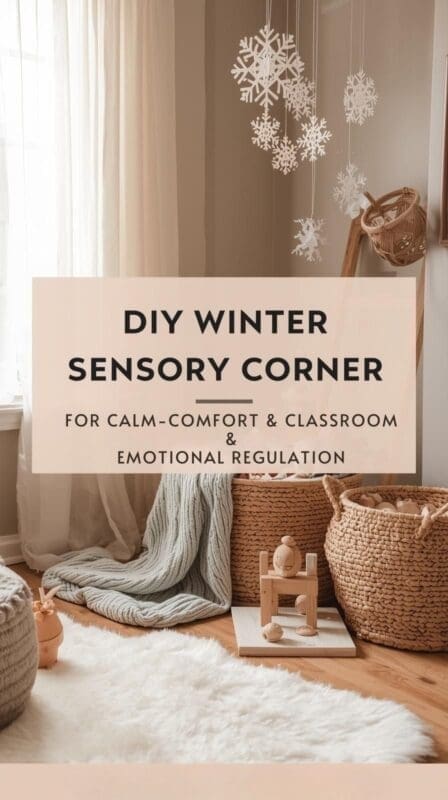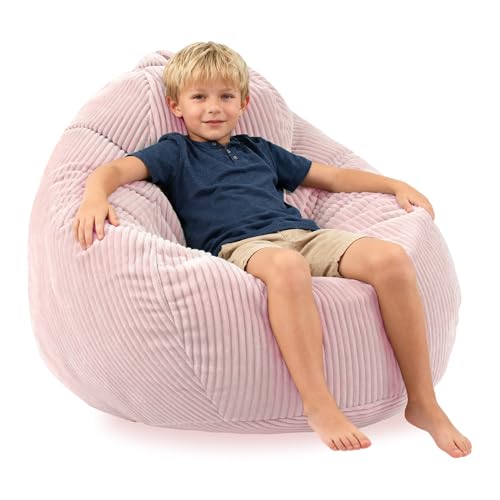It’s important to disclose that this blog post contains affiliate links. This means that if you make a purchase through these links, we may earn a commission at no additional cost to you.
When Winter Quiet Feels a Little Too Quiet
Last January, our counseling wing felt unusually still. The hallways were calm but heavy — fewer recess breaks, colder mornings, and that unmistakable midwinter fatigue that hangs in the air. One of my students, who usually bounded into group sessions, sat quietly in the corner and said, “I just feel…stuck.”
That word stayed with me.
Winter tends to slow everything — including our energy, movement, and emotional flexibility. But for children (and even adults) with sensitive nervous systems, that stillness can turn into dysregulation. The cold, the gray, the layers — they dull the senses and leave the body craving warmth, texture, and light.
That’s why I started building what I call a Winter Sensory Corner in my therapy office: a cozy, low-cost space where calm can return through sensory input.
In this guide, we’ll create your own DIY Winter Sensory Corner — a small, intentional setup that blends design, psychology, and creativity. Whether you’re a school counselor, therapist, or teacher, this simple transformation can make your space feel like a breath of warm air on the coldest day.
Why Sensory Corners Matter More in Winter
Winter shifts the sensory landscape — less sunlight, fewer outdoor textures, and more time spent in visually uniform classrooms or offices. For many children, this means reduced sensory variety and increased emotional reactivity.
🧠 The Psychology
From a psychological standpoint, sensory experiences regulate emotional states. When the environment feels cold or sterile, the brain unconsciously seeks stimulation through fidgeting, noise, or movement. A sensory-rich environment redirects that impulse safely.
👐 The Occupational Therapy Perspective
Occupational therapists often describe the sensory corner as a “reset station.” In winter, it can:
- Provide deep pressure input (weighted blankets, soft cushions) to calm overstimulation.
- Offer visual grounding (soft light, neutral tones) to reduce anxiety.
- Stimulate tactile curiosity (textures, fabrics, play materials) to reawaken engagement.
Therapist Insight:
“A sensory corner isn’t about distraction — it’s about teaching the body how to come back to calm. It’s a safe bridge between overwhelm and focus.”
Core Elements of a Winter Sensory Corner
Think of your winter sensory corner as a multisensory experience designed for warmth, softness, and emotional grounding. Each element can be layered gradually — you don’t need to buy everything at once.
1. Soft Textures & Weighted Comfort
What to Include:
- Weighted lap pad or small blanket
- Faux fur or sherpa throw
- Textured rug or foam floor mat
- Plush floor cushion or bean bag
Why It Works:
Deep pressure on the body triggers serotonin and dopamine release — nature’s “slow down” chemicals. Weighted items mimic a gentle hug, providing proprioceptive input that lowers anxiety.
2. Gentle Winter Lighting
What to Include:
- Warm-toned LED fairy lights
- Himalayan salt lamp or diffuser lamp
- Battery-operated candles
Why It Works:
Soft amber light reduces cortisol and helps balance melatonin production during darker months. It transforms harsh classroom corners into emotional sanctuaries.
Therapist Tip: Keep lighting under eye level for children — it feels grounding and contained.
3. Soothing Scents & Soundscape
What to Include:
- Essential oil diffuser (lavender, pine, or peppermint)
- Low-volume nature sound playlist or white noise machine
Why It Works:
Scents like cedarwood and vanilla anchor the nervous system in familiarity. Sound layers provide sensory predictability, helping children focus and breathe more evenly.
4. Visual Calm Through Color & Decor
What to Include:
- Winter palette: soft blue, ivory, and sage
- Wall prints with affirmations like “Breathe in calm, exhale courage”
- Simple snowflake garland or cotton “snow” for gentle movement
Why It Works:
Neutral, natural color palettes lower visual load, reducing overstimulation. Motion (like soft fabric or hanging snowflakes) captures gentle attention without chaos.
Step-by-Step DIY Setup
Here’s how to create your sensory haven — even in a small corner or office nook.
Step 1: Pick Your Space
Choose a quiet corner with minimal foot traffic. Corners near windows work well (natural light = regulation), but avoid direct glare or cold drafts.
Step 2: Define Zones
- Ground Zone: Textures (rug, cushion, weighted item)
- Wall Zone: Visual calm (art, lights, affirmations)
- Air Zone: Scent and sound (diffuser, soft playlist)
Step 3: Add a “Choice Menu”
Laminate a small card with calming options: “Would you like to hold a fidget? Sit quietly? Smell lavender? Write your feeling?”
This empowers autonomy — a cornerstone of self-regulation.
Step 4: Integrate Winter Decor
Add one or two soft seasonal touches — like a cotton snow garland or a pine-scented sachet. Avoid clutter. The goal is comfort, not Christmas.
Mindful Note:
Every element should say, “You can pause here.”
Sensory Tools That Support Emotional Regulation
A winter sensory corner is both décor and function. Mix tools that appeal to touch, sight, sound, and smell — the four most accessible senses in classroom or therapy settings.
| Type | Example Tools | Therapeutic Benefit |
|---|---|---|
| Tactile | Textured stress balls, kinetic sand, plush fabric | Enhances grounding and fine-motor skills |
| Visual | Glitter calm jar, slow-moving bubble timer | Promotes mindfulness and visual focus |
| Auditory | Mini wind chime, white noise device | Reduces auditory overload |
| Olfactory | Essential oil cotton ball jar (lavender, pine) | Anchors attention through scent memory |
| Proprioceptive | Weighted lap pad, stretch bands | Calms body through deep pressure input |
Winter-Themed Sensory Activities
These quick, seasonal sensory ideas can rotate weekly to keep the space fresh and engaging — perfect for counselor-led groups or self-regulation breaks.
1. Snow Sensory Bin
Supplies: Shaved ice or fake snow, scoops, mini cups.
Activity: Let kids dig, pour, and scoop while practicing descriptive words (cold, crunchy, smooth).
Why It Works: Engages touch and language simultaneously — ideal for calming transitions.
2. Glitter “Snowfall” Calm Jar
Supplies: Jar, glitter, glycerin, water.
Activity: Shake and watch glitter settle while taking deep breaths.
Why It Works: Mimics mindfulness — when the glitter settles, so does the mind.
3. Frozen Treasure Hunt
Supplies: Ice cubes with small beads or charms frozen inside.
Activity: Let students melt the ice slowly in warm water while reflecting on patience and process.
Why It Works: Builds frustration tolerance and fine-motor control.
4. Winter Scent Exploration
Supplies: Cotton pads with essential oils (pine, orange, cinnamon).
Activity: Guess the scent, then match it to an emotion or memory.
Why It Works: Strengthens interoception — the awareness of inner feelings linked to sensory input.
5. Mindful Coloring Station
Supplies: Printable snowflake mandalas, colored pencils.
Activity: Encourage slow coloring, matching breath to movement.
Why It Works: Combines bilateral coordination with emotional centering.
Printable idea: Offer a free “Snowflake Mandala Coloring Sheet” to grow your email list.
Maintaining Calm Energy Through the Season
A sensory corner thrives on consistency. Refresh it gently each month — not with new items, but with new intentions.
Monthly Themes Example:
- December: “Warmth & Belonging” — focus on weighted comfort items.
- January: “Focus & Renewal” — add new visual affirmations.
- February: “Connection & Kindness” — include heart-themed sensory crafts.
Maintenance Tips:
- Rotate scents every few weeks to avoid sensory fatigue.
- Keep materials clean and visually simple.
- Encourage students to help reset or tidy the space — shared responsibility builds ownership.
Counselor Reflection Prompt:
“What part of my space helps me regulate? How can I model that for my students?”
When Calm Becomes a Corner
A Winter Sensory Corner isn’t just décor — it’s a quiet act of emotional care.
Each soft blanket, each glowing light, each jar of glitter says, “You can slow down here.”
Whether you create it for your students, clients, or yourself, this space becomes a daily reminder that sensory regulation is a form of self-respect.
You might also like:
- DIY Winter Therapy Office Decor Ideas
- Mindful Art Projects for Counselors
- Winter Crafts for Kids That Support Emotional Well-Being
Because healing isn’t just something we teach — it’s something we practice, one mindful corner at a time.

About the Author
Hi, I’m Eve, a former school counselor with a master’s degree in School Psychology and a passionate advocate for children and families navigating sensory challenges. As a mom of children with sensory sensitivities, I deeply understand the journey special-needs parents face, and I dedicate myself to researching and sharing practical solutions to help children thrive and feel comfortable in their bodies. My goal is also to empower counselors, therapists, and psychologists with creative strategies and supportive resources to enrich their everyday practice. When I’m not writing or exploring new therapeutic approaches, you’ll find me spending quality time with my family and continually seeking inspiration from everyday moments.








